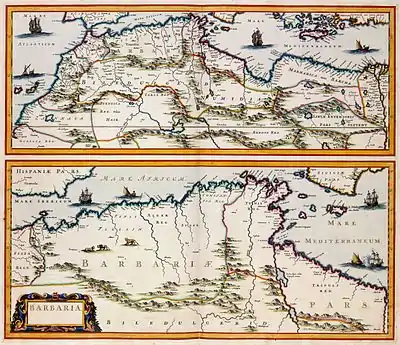Barbary Coast
The Barbary Coast (also Barbary, Berbery or Berber Coast) was the coastal regions of North Africa or Maghreb, specifically the Ottoman borderlands consisting of the regencies in Algiers and Tripoli, as well as the Beylik of Tunis and the Sultanate of Morocco from the 16th to 19th centuries.[1][2][3] The term originates from the exonym of the Berbers.[4][5]

History

Barbary was not always a unified political entity. From the 16th century onwards, it was divided into the political entities of the Regency of Algiers, Tripolitania, Beylik of Tunis, and Sharifan Empire. Major rulers and petty monarchs during the times of the Barbary States' plundering parties included the Dey of Algiers, the Pasha of Tripoli, the Bey of Tunis, and the Sultan of Morocco.[6]
In 1625, Algiers' pirate fleet (by far the largest) numbered 100 ships of various sizes employing 8,000 to 10,000 men. The corsair industry accounted for 25 percent of the workforce of the city, not counting other activities related directly to the port. The fleet averaged 25 ships in the 1680s, but these were larger vessels than had been used since the 1620s, thus the fleet still employed some 7,000 men. In addition 2,500 men manned the pirate fleet of Tripoli, 3,000 in Tunis, and several thousand more in all the various minor pirate bases such as Bona, Susa, Bizerta, and Salé. The corsairs were not solely natives of their cities; while many were Arabs and Berbers, there were also Turks, Greeks, Albanians, Syrians, and renegade Italians (especially Corsicans) among their number.[7]

The first military land action overseas by the United States was executed by the US Marines and the US Navy in 1805 at the Battle of Derna, Tripoli, a coastal town now in eastern Libya, in April 1805. It formed part of an effort to destroy all Barbary pirates, to reclaim American slaves in captivity and end piracy acts between the warring tribes on the part of the Barbary states, which were themselves member states of the Ottoman Empire. The opening line of the Marines' Hymn refers to this action: "From the halls of Montezuma to the shores of Tripoli...".
See also
- Langue de Barbarie
- Ottoman Algeria – 1516–1830 Ottoman state in North Africa
- Ottoman Tripolitania – 1551–1912 Ottoman rule in modern Libya
- Beylik of Tunis – Monarchy in Northern Africa between 1705 and 1881
- Republic of Salé – 17th-century city-state in North Africa
- Sharifan Empire – History of human habitation in Morocco, since prehistoric times
- Tunisian navy (1705–1881)
- Turkish Abductions – Barbary slave raids against Iceland
References
- Ben Rejeb, Lotfi (2012). "'The general belief of the world': Barbary as genre and discourse in Mediterranean history". European Review of History: Revue européenne d'histoire. 19 (1): 15. doi:10.1080/13507486.2012.643607. S2CID 159990075.
- Hinz, Almut (2006). "Die "Seeräuberei der Barbareskenstaaten" im Lichte des europäischen und islamischen Völkerrechts". Verfassung und Recht in Übersee / Law and Politics in Africa, Asia and Latin America. 39 (1): 46–65. JSTOR 43239304.
- The Department of State bulletin. 1939. p. 3.
- "Barbary | historical region, Africa | Britannica". www.britannica.com. Retrieved 2021-12-14.
- Murray, Hugh (1841). The Encyclopædia of Geography: Comprising a Complete Description of the Earth, Physical, Statistical, Civil, and Political. Lea and Blanchard.
- Chisholm, Hugh, ed. (1911). . Encyclopædia Britannica. Vol. 3 (11th ed.). Cambridge University Press. pp. 383–384.
- Gregory Hanlon. "The Twilight Of A Military Tradition: Italian Aristocrats And European Conflicts, 1560-1800." Routledge: 1997. Pages 27-28.
Sources
- London, Joshua E. (2005), Victory in Tripoli: How America's War with the Barbary Pirates Established the U.S. Navy and Shaped a Nation, New Jersey: John Wiley & Sons, Inc., ISBN 0-471-44415-4
- LAFI (Nora), Une ville du Maghreb entre ancien régime et réformes ottomanes. Genèse des institutions municipales à Tripoli de Barbarie (1795–1911), Paris: L'Harmattan, 2002, p. 305
